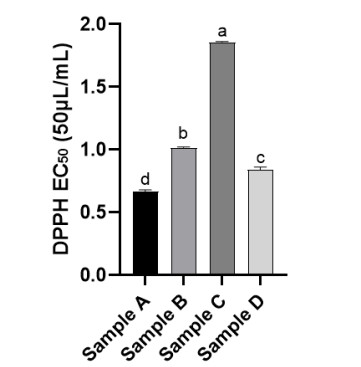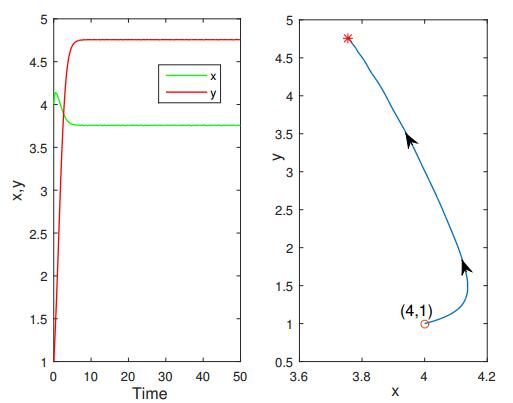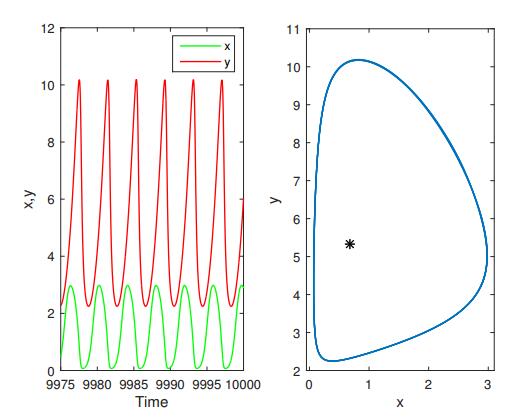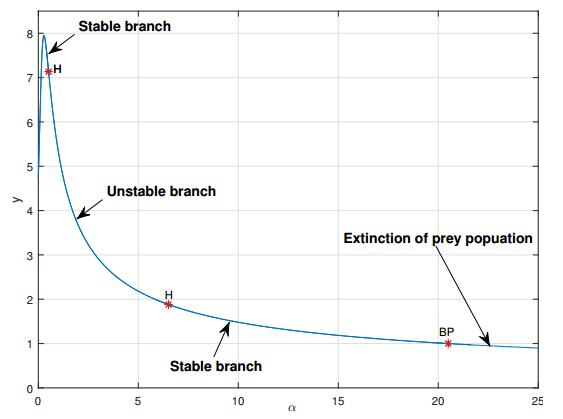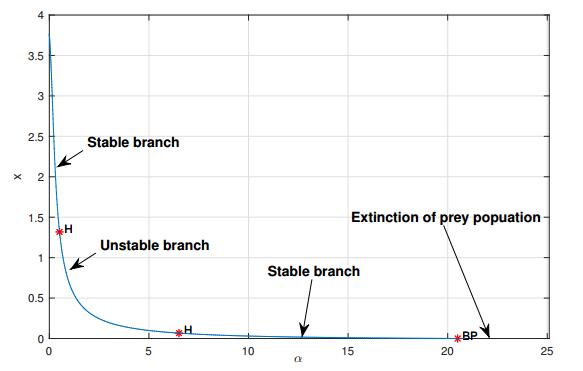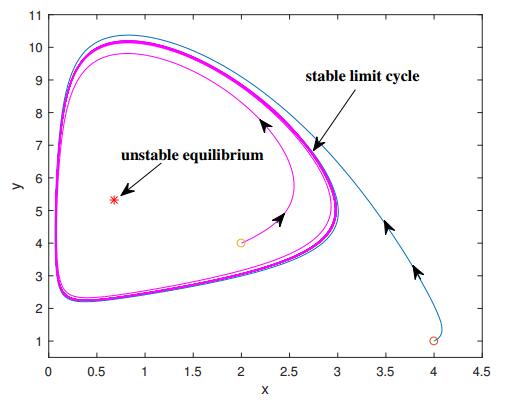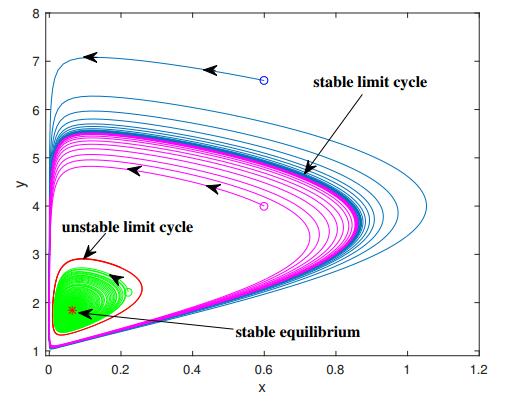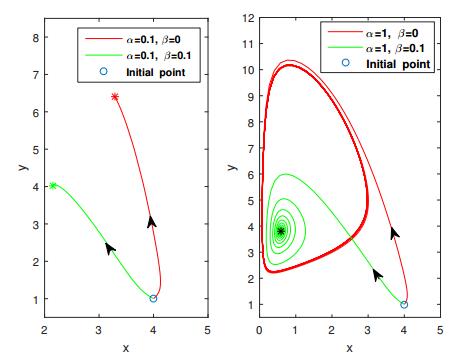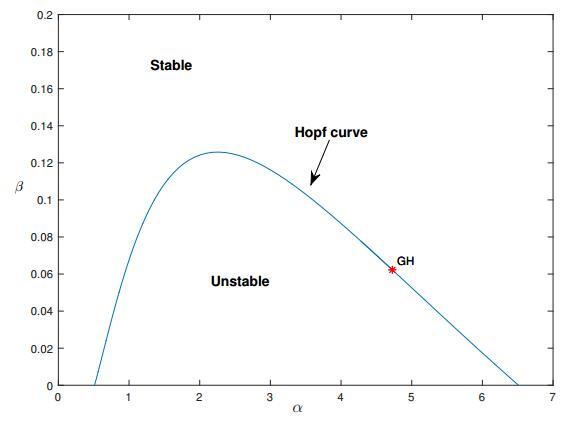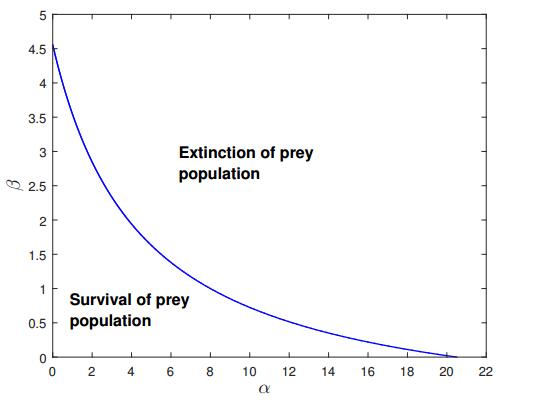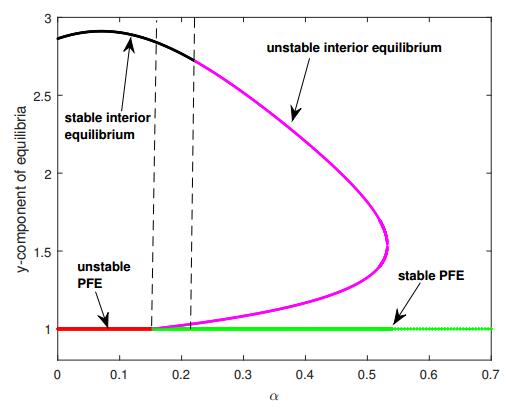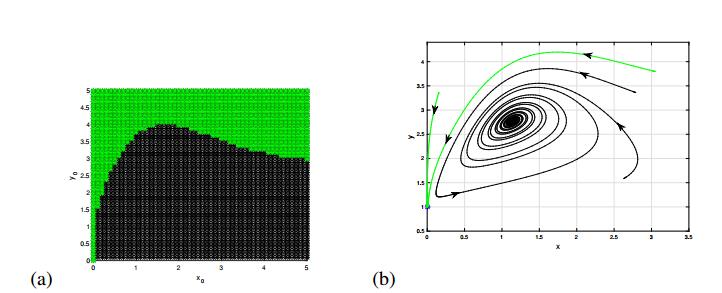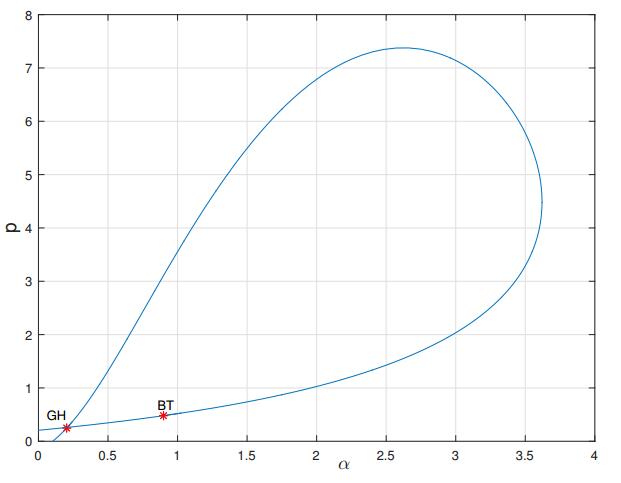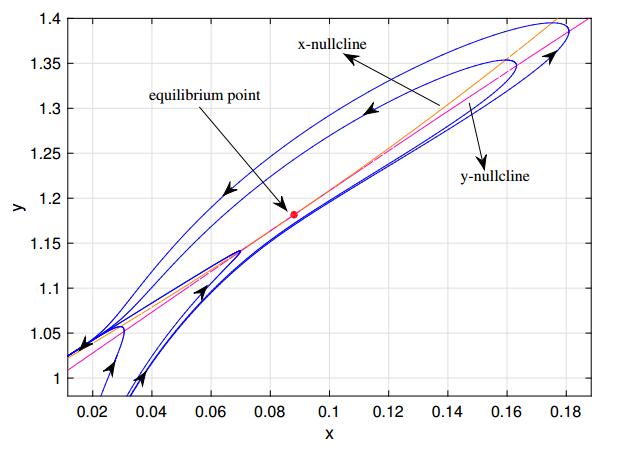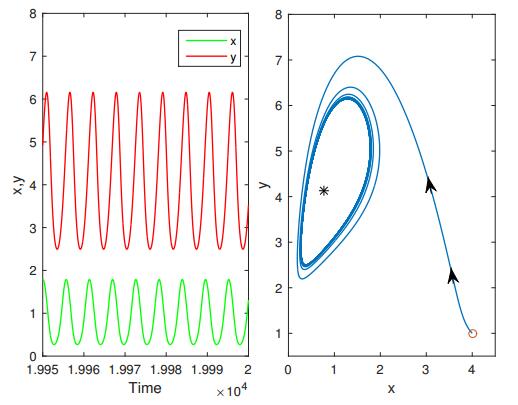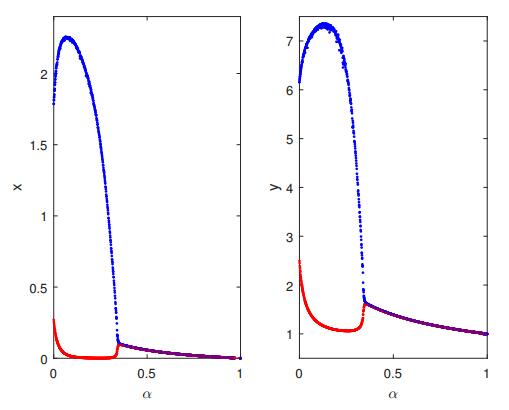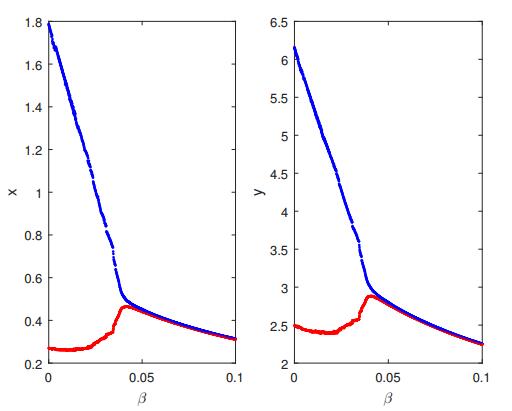|
[1]
|
P. Leslie and J. Gower, The properties of a stochastic model for the predator-prey type of interac-tion between two species, Biometrika, 47 (1960), 219–234.
|
|
[2]
|
P. Leslie, Some further notes on the use of matrices in population mathematics, Biometrika, 35 (1948), 213–245.
|
|
[3]
|
M. Aziz-Alaouiand M.D. Okiye, Boundednessand globalstability for apredator-prey modelwith modified LeslieGower and Holling-type II schemes, Appl. Math. Lett., 16 (2003), 1069–1075.
|
|
[4]
|
A. Nindjin, M. Aziz-Alaoui and M. Cadivel, Analysis of a predator–prey model with modified Leslie–Gower and Holling-type II schemes with time delay, Nonlinear Anal. R. World Appl., 7 (2006), 1104–1118.
|
|
[5]
|
R. Gupta and P. Chandra, Bifurcation analysis of modified Leslie–Gower predator–prey model with Michaelis–Menten type prey harvesting, J. Math. Anal. Appl., 398 (2013), 278-295.
|
|
[6]
|
Y. Zhu and K. Wang, Existence and global attractivity of positive periodic solutions for a preda-torprey model with modified Leslie–Gower Holling-type II schemes, J. Math. Anal. Appl., 384 (2011), 400–408.
|
|
[7]
|
P. E. Stander, Cooperative hunting in lions: the role of the individual, Behav. Ecol. Sociobiol., 29 (1992), 445–454.
|
|
[8]
|
S. Creel and N. M. Creel, Communal hunting and pack size in African wild dogs, Lycaon pictus, Animal Behav., 50 (1995), 1325–1339.
|
|
[9]
|
C. Boesch, Cooperative hunting in wild chimpanzees, Animal Behav., 48 (1994), 653–667.
|
|
[10]
|
D. L. Mech, The Wolf, Natural History Press, New York, 1970.
|
|
[11]
|
D. P. Hector, Cooperative hunting and its relationship to foraging success and prey size in an avian predator, Ethology, 73 (1986), 247–257.
|
|
[12]
|
P. M. Kappeler and C. P. Van Schaik, Cooperation in Primates and Humans: Mechanisms and Evolution, Springer, Berlin, 2006.
|
|
[13]
|
P. S. Rodman, Inclusive fitness and group size with a reconsideration of group sizes in lions and wolves, Am. Nat., 118 (1981), 275–283.
|
|
[14]
|
J. McNutt, L. Boggs, H. Heldring, et al., Running wild: dispelling the myths of the African wild dog, Smithsonian Institution Press, Washington D.C., 1996.
|
|
[15]
|
I. Bailey, J. P. Myatt and A. M. Wilson, Group hunting within the carnivora: physiological, cognitive and environmental influences on strategy and cooperation, Behav. Ecol. Sociobiol., 67 (2013), 1–17.
|
|
[16]
|
M. Fox, Behaviour of wolves dogs and related canids, Harper and Row, New York, 1971.
|
|
[17]
|
D. W. Macdonald, The ecology of carnivore social behaviour, Nature, 301 (1983), 379.
|
|
[18]
|
J. C. Bednarz, Cooperative hunting Harris' hawks (Parabuteo unicinctus), Science, 239 (1988), 1525–1527.
|
|
[19]
|
T. Pitcher, A. Magurran and I. Winfield, Fish in larger shoals find food faster, Behav. Ecol. Sociobiol., 10 (1982), 149–151.
|
|
[20]
|
H. J. Brockmann and C. Barnard, Kleptoparasitism in birds, Animal Behav., 27 (1979), 487–514.
|
|
[21]
|
J. A. Vucetich, R. O. Peterson and T. A. Waite, Raven scavenging favours group foraging in wolves, Animal Behav., 67 (2004), 1117–1126.
|
|
[22]
|
C. Packer and L. Ruttan, The evolution of cooperative hunting, Am. Nat., 132 (1988), 159–198.
|
|
[23]
|
S. L. Lima, Nonlethal effects in the ecology of predator-prey interactions, Bioscience, 48 (1998), 25–34.
|
|
[24]
|
W. Cresswell, Predation in bird populations, J. Ornithol., 152 (2011), 251–263.
|
|
[25]
|
K. B. Altendorf, J. W. Laundré, C. A. López González, et al., Assessing effects of predation risk on foraging behavior of mule deer, J. Mammal., 82 (2001), 430–439.
|
|
[26]
|
S. Creel, D. Christianson, S. Liley, et al., Predation risk affects reproductive physiology and demography of elk, Science, 315 (2007), 960.
|
|
[27]
|
L. Y. Zanette, A. F. White, M. C. Allen, et al. Perceived predation risk reduces the number of offspring songbirds produce per year, Science, 334 (2011), 1398–1401.
|
|
[28]
|
F. Hua, K. E. Sieving, R. J. Fletcher, et al., Increased perception of predation risk to adults and offspring alters avian reproductive strategy and performance, Behav. Ecol., 25 (2014), 509–519.
|
|
[29]
|
J. P. Suraci, M. Clinchy, L. M. Dill, et al., Fear of large carnivores causes a trophic cascade, Nat. Commun., 7 (2016), 10698.
|
|
[30]
|
M. J. Peers, Y. N. Majchrzak, E. Neilson, et al., Quantifying fear effects on prey demography in nature, Ecology, 99 (2018), 1716–1723.
|
|
[31]
|
A. Sih, Optimal behavior: can foragers balance two conflicting demands?, Science, 210 (1980), 1041–1043.
|
|
[32]
|
A. Sih, Prey uncertainty and the balancing of antipredator and feeding needs, Am. Nat., 139 (1992), 1052–1069.
|
|
[33]
|
A. I. Houston and J. M. McNamara, Models of adaptive behaviour: an approach based on state, Cambridge University Press, Cambridge, 1999.
|
|
[34]
|
Z. Abramsky, M. L. Rosenzweig and A. Subach, The costs of apprehensive foraging, Ecology, 83 (2002), 1330 –1340.
|
|
[35]
|
M. A. Elgar, Predator vigilance and group size in mammals and birds: a critical review of the empirical evidence, Biol. Rev., 64 (1989), 13–33.
|
|
[36]
|
A. Sih and T. M. McCarthy, Prey responses to pulses of risk and safety: testing the risk allocation hypothesis, Animal Behav., 63 (2002), 437–443.
|
|
[37]
|
D. T. Blumstein and J. C. Daniel, Isolation from mammalian predators differentially affects two congeners, Behav. Ecol., 13 (2002), 657–663.
|
|
[38]
|
S. Creel and J. A. Winnie Jr., Responses of elk herd size to fine-scale spatial and temporal variation in the risk of predation by wolves, Animal Behav., 69 (2005), 1181–1189.
|
|
[39]
|
J. Duarte, C. Januário, N. Martins, et al., Chaos and crises in a model for cooperative hunting: A symbolic dynamics approach, Chaos, 19 (2009), 043102.
|
|
[40]
|
L. Berec, Impacts of foraging facilitation among predators on predator–prey dynamics, Bull. Math. Biol., 72 (2010), 94–121.
|
|
[41]
|
M. Teixeira Alves and F. M. Hilker, Hunting cooperation and Allee effects in predators, J. Theor. Biol., 419 (2017), 13–22.
|
|
[42]
|
L. Pˇ ribylová and A. Peniaˇ sková, Foraging facilitation among predators and its impact on the stability of predator–prey dynamics, Ecol. Complex., 29 (2017), 30–39.
|
|
[43]
|
S. Pal, N. Pal and J. Chattopadhyay, Hunting cooperation in a discrete-time predator-prey system, Int. J. Bifurc. Chaos Appl. Sci. Eng., 28 (2018), 1850083.
|
|
[44]
|
X. Wang, L. Y. Zanette and X. Zou, Modelling the fear effect in predator–prey interactions, J. Math. Biol, 73 (2016), 1179–1204.
|
|
[45]
|
X. Wang and X. Zou, Modeling the fear effect in predator-prey interactions with adaptive avoid-ance of predators, Bull. Math. Biol., 79 (2017), 1325–1359.
|
|
[46]
|
P. Panday, N. Pal, S. Samanta, et al., Stability and bifurcation analysis of a three-species food chain model with fear, Int. J. Bifurc. Chaos Appl. Sci. Eng., 28 (2018), 1850009.
|
|
[47]
|
S. K. Sasmal, Population dynamics with multiple Allee effects induced by fear factors–A mathe-matical study on prey–predator interactions, Appl. Math Model., 64 (2018), 1–14.
|
|
[48]
|
S. Pal, S. Majhi, S. Mandal, et al., Role of fear in a predator–prey model with Beddington-DeAngelis functional response, Z. Naturforsch. A, 74 (2019) DOI: 10.1515/zna-2018-0449.
|
|
[49]
|
A. Sha, S. Samanta, M. Martcheva, et al., Backward bifurcation, oscillations and chaos in an eco-epidemiological model with fear effect, J. Biol. Dyn., 13 (2019), 301–327.
|
|
[50]
|
P. A. Schmidt and L. D. Mech, Wolf pack size and food acquisition, Am. Nat., 150 (1997), 513–517.
|
|
[51]
|
N. Courbin, A. J. Loveridge, D. Macdonald, et al. Reactive responses of zebras to lion encounters shape their predator–prey space game at large scale, Oikos, 125 (2016), 829–838.
|
|
[52]
|
S. Periquet, M. Valeix, A. J. Loveridge, et al., Individual vigilance of African herbivores while drinking: the role of immediate predation risk and context, Animal Behav., 79 (2010), 665–671.
|
|
[53]
|
W. J. Ripple and E. J. Larsen, Historic aspen recruitment, elk, and wolves in northern Yellowstone National Park, USA, Biol. Conserv., 95 (2000), 361–370.
|
|
[54]
|
S. Creel, J. A. Winnie Jr, B. Maxwell, et al., Elk alter habitat selection as an antipredator response to wolves, Ecology, 86 (2005), 3387–3397.
|
|
[55]
|
J. A. Winnie Jr, D. Christianson, S. Creel, et al., Elk decision-making rules are simplified in the presence of wolves, Behav. Ecol. Sociobiol., 61 (2006), 277.
|
|
[56]
|
J. A. Winnie Jr, and S. Creel, Sex-specific behavioural responses of elk to spatial and temporal variation in the threat of wolf predation, Animal Behav., 73 (2007), 215–225.
|
|
[57]
|
D. W. Stephens and J. R. Krebs, Foraging theory, Princeton University Press, Princeton, New Jersey, 1986.
|
|
[58]
|
Z. Zhang, Mutualism or cooperation among competitors promotes coexistence and competitive ability, Ecol. Model., 164 (2003), 271–282.
|
|
[59]
|
M. J. Hamilton, O. Burger, J. P. DeLong, et al., Population stability, cooperation, and the invasi-bility of the human species, Proc. Natl. Acad. Sci. U.S.A., 106 (2009), 12255–12260.
|
|
[60]
|
K. Kundu, S. Pal, S. Samanta, et al., Impact of fear effect in a discrete-time predator-prey system, Bull. Calcutta Math. Soc., 110 (2018), 245–264.
|
|
[61]
|
H. R. Thieme, Mathematics in population biology, Princeton University Press, Princeton, New Jersey, 2003.
|
|
[62]
|
F. Chen, On a nonlinear nonautonomous predator–prey model with diffusion and distributed delay, J. Comput. Appl. Math., 180 (2005), 33–49.
|
|
[63]
|
S. Wiggins, Introduction to Applied Nonlinear Dynamical Systems and Chaos, Vol. 2, Springer, New York, 1990.
|
|
[64]
|
Y. A. Kuznetsov, Elements of Applied Bifurcation Theory, Vol. 112, Springer, New York, USA, 1998.
|
|
[65]
|
S. Pal, N. Pal, S. Samanta, et al., A predator-prey model with hunting cooperation and fear, Ecol. Complex., Under review, (M.S. no: ECOCOM-2019-21).
|









 DownLoad:
DownLoad:
